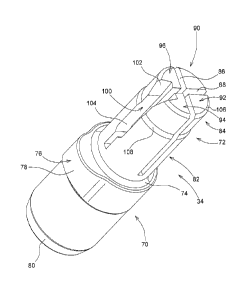Some of the information on this Web page has been provided by external sources. The Government of Canada is not responsible for the accuracy, reliability or currency of the information supplied by external sources. Users wishing to rely upon this information should consult directly with the source of the information. Content provided by external sources is not subject to official languages, privacy and accessibility requirements.
Any discrepancies in the text and image of the Claims and Abstract are due to differing posting times. Text of the Claims and Abstract are posted:
| (12) Patent: | (11) CA 2867825 |
|---|---|
| (54) English Title: | COUPLER ASSEMBLY |
| (54) French Title: | ENSEMBLE D'ACCOUPLEMENT |
| Status: | Granted |
| (51) International Patent Classification (IPC): |
|
|---|---|
| (72) Inventors : |
|
| (73) Owners : |
|
| (71) Applicants : |
|
| (74) Agent: | BORDEN LADNER GERVAIS LLP |
| (74) Associate agent: | |
| (45) Issued: | 2022-03-15 |
| (22) Filed Date: | 2014-10-17 |
| (41) Open to Public Inspection: | 2015-04-30 |
| Examination requested: | 2019-09-17 |
| Availability of licence: | N/A |
| (25) Language of filing: | English |
| Patent Cooperation Treaty (PCT): | No |
|---|
| (30) Application Priority Data: | ||||||
|---|---|---|---|---|---|---|
|
A coupler pin couples an output sleeve of rotary unit to an input member of a rotary sensor with interference fits. The coupler pin has a first part and a second part. A key groove is formed in an inner surface of a coupling bore in the output sleeve. The first part is received by the coupling bore, and the first part has a key member which is received by the key groove. The second part has a key slot formed therein. The input member has a key. The key has a slip fit with a first part of the key slot and has an interference fit with a second part of the key slot. The key projects inwardly from a wall of a coupling bore in the input member. The second part is divided into a plurality of sections by axially extending cross-cuts.
Une broche de couplage relie le manchon de sortie dune unité rotative à lélément dentrée dun capteur rotatif ayant des ajustements serrés. La broche de couplage comprend une première partie et une deuxième partie. On forme une rainure de clavette dans la surface interne dun tube de couplage taillé dans le manchon de sortie. Le tube de couplage peut accommoder la première partie et cette dernière comprend un élément de clavette qui sintroduit dans la rainure de clavette. La deuxième partie comprend une fente de clavette qui y est taillée. Lélément dentrée comprend une clavette. La clavette comprend un ajustement glissant ayant une première partie de la fente de clavette et un ajustement serré ayant une deuxième partie de la fente de clavette. La clavette saillit vers lintérieur à partir dun mur du tube de couplage constituant lélément dentrée. La deuxième partie est divisée en plusieurs zones par des coupes perpendiculaires axiales.
Note: Claims are shown in the official language in which they were submitted.
Note: Descriptions are shown in the official language in which they were submitted.

For a clearer understanding of the status of the application/patent presented on this page, the site Disclaimer , as well as the definitions for Patent , Administrative Status , Maintenance Fee and Payment History should be consulted.
| Title | Date |
|---|---|
| Forecasted Issue Date | 2022-03-15 |
| (22) Filed | 2014-10-17 |
| (41) Open to Public Inspection | 2015-04-30 |
| Examination Requested | 2019-09-17 |
| (45) Issued | 2022-03-15 |
There is no abandonment history.
Last Payment of $210.51 was received on 2023-10-13
Upcoming maintenance fee amounts
| Description | Date | Amount |
|---|---|---|
| Next Payment if standard fee | 2024-10-17 | $347.00 |
| Next Payment if small entity fee | 2024-10-17 | $125.00 |
Note : If the full payment has not been received on or before the date indicated, a further fee may be required which may be one of the following
Patent fees are adjusted on the 1st of January every year. The amounts above are the current amounts if received by December 31 of the current year.
Please refer to the CIPO
Patent Fees
web page to see all current fee amounts.
| Fee Type | Anniversary Year | Due Date | Amount Paid | Paid Date |
|---|---|---|---|---|
| Application Fee | $400.00 | 2014-10-17 | ||
| Maintenance Fee - Application - New Act | 2 | 2016-10-17 | $100.00 | 2016-10-03 |
| Maintenance Fee - Application - New Act | 3 | 2017-10-17 | $100.00 | 2017-10-04 |
| Maintenance Fee - Application - New Act | 4 | 2018-10-17 | $100.00 | 2018-10-02 |
| Request for Examination | $800.00 | 2019-09-17 | ||
| Maintenance Fee - Application - New Act | 5 | 2019-10-17 | $200.00 | 2019-09-30 |
| Maintenance Fee - Application - New Act | 6 | 2020-10-19 | $200.00 | 2020-10-09 |
| Maintenance Fee - Application - New Act | 7 | 2021-10-18 | $204.00 | 2021-10-11 |
| Final Fee | 2022-01-17 | $306.00 | 2021-12-30 | |
| Maintenance Fee - Patent - New Act | 8 | 2022-10-17 | $203.59 | 2022-10-07 |
| Maintenance Fee - Patent - New Act | 9 | 2023-10-17 | $210.51 | 2023-10-13 |
Note: Records showing the ownership history in alphabetical order.
| Current Owners on Record |
|---|
| DEERE & COMPANY |
| Past Owners on Record |
|---|
| None |